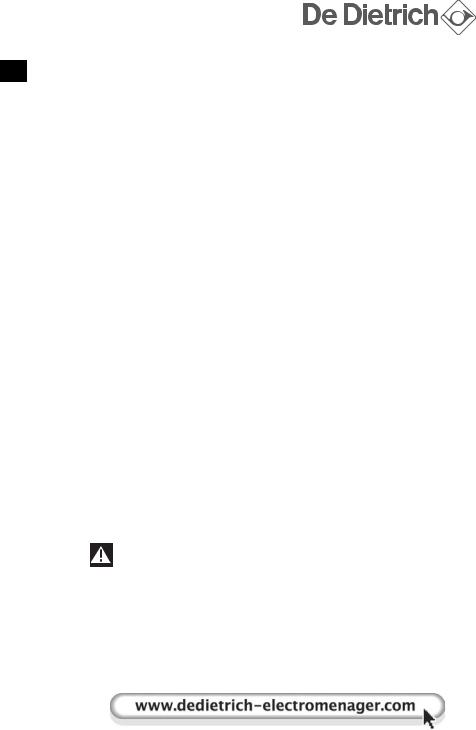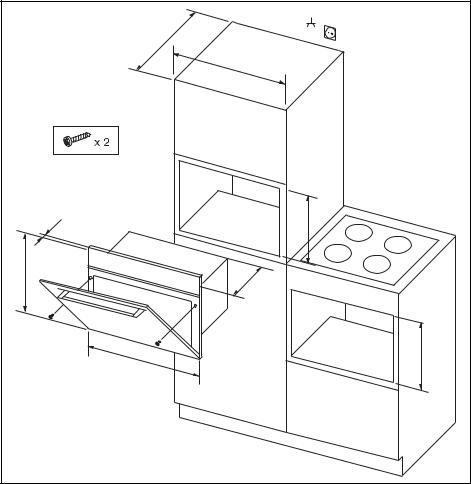DE DIETRICH DME785 User Manual

EN INSTRUCTIONS FOR USE
Microwave oven

EN |
23 |
Dear Customer, |
|
You have just acquired a DE DIETRICH microwave oven and we would like to thank you.
Our research teams have created this new generation of appliances for you. Their quality, design, features and technological advances make them exceptional products, and reveal our unique know-how.
Your new DE DIETRICH microwave oven will blend harmoniously into your kitchen and will perfectly combine performance adapted to the food being cooked and ease of use. We wanted to offer you a pro-duct of excellence.
In the DE DIETRICH product line, you will also find a wide range of ovens, hobs, hoods, dishwashers and fridges, that you can coordinate with your new DE DIETRICH microwave oven.
Of course, in an ongoing effort to best satisfy your demands with regard to our products, our after-sales service department is at your disposal and ready to listen in order to respond to all of your questions and suggestions (contact information at the end of this booklet).
Visit our website www.dedietrich-electromenager.com, where you will find our latest innovations as well as useful and complementary information.
DE DIETRICH
Setting New Values
As part of our commitment to constantly improving our products, we reserve the right to make changes to them based on technological advances to their technical and functional features and appearance.
Warning: Before installing and using your appliance, please carefully read this Guide to Installation and Use, which will allow you to quickly familiarise yourself with its operation.

TABLE OF CONTENTS |
EN |
1/NOTICES TO THE USER |
|
• Safety instructions ............................................................................ |
26 |
• Operating principle............................................................................ |
27 |
• Environmental protection .................................................................. |
27 |
2/INSTALLING YOUR APPLIANCE |
|
• Before connecting............................................................................. |
28 |
• Electrical connection......................................................................... |
28 |
• Build-in .............................................................................................. |
29 |
3/DESCRIPTION OF YOUR APPLIANCE |
|
• The appliance ................................................................................... |
30 |
• Accessories....................................................................................... |
31 |
• The control panel .............................................................................. |
32 |
• The display........................................................................................ |
33 |
4/USING YOUR APPLIANCE |
|
• How to set and change the time....................................................... |
34 |
• Child safety ....................................................................................... |
34 |
• Programming .................................................................................... |
35 |
• Using the power levels ..................................................................... |
35 |
• Microwave function ........................................................................... |
36 |
• Reheating on 2 levels ....................................................................... |
36 |
• Defrosting.......................................................................................... |
37 |
• The SPEED DEFROST function....................................................... |
38 |
• Defrosting guide................................................................................ |
39 |
• The Keep warm function................................................................... |
40 |
• M1/M2/M3 memory buttons .............................................................. |
40 |
• Delayed start..................................................................................... |
41 |
5/CARING FOR AND CLEANING YOUR APPLIANCE ............................... |
41 |
6/IN THE EVENT OF OPERATING ANOMALIES ....................................... |
42 |
7/OPERATING PROFICIENCY TESTING ................................................... |
43 |
25

EN 1/NOTICES TO THE USER
Warning:
Keep this user guide with your appliance. If the appliance is ever sold or transferred to another person, ensure that the new owner receives the user guide. Please become familiar with these recommendations before installing and using your oven. They were written for your safety and the safety of others.
• SAFETY INSTRUCTIONS
Your appliance is intended exclusively for domestic use for cooking, reheating and defrosting food. The manufacturer declines all responsibility in the event of improper use.
Check that utensils are suitable for use in a microwave oven.
To avoid damage to your appliance, never operate it when empty or without the turntable.
Do not tamper with the holes of the front lock, as this could damage your appliance and result in the need for repair.
The seal and the frame of the door must be inspected regularly to ensure that they are not damaged. If these areas become damaged, stop using the appliance and have it checked by a specialised technician.
When heating food in plastic or paper containers, keep an eye on the oven due to the risk of fire.
When using the microwave and microwave + fan cooking function, you should avoid using metal containers, forks, spoons, knives or metal fasteners or staples for freezer bags.
The contents of bottles or jars for babies must be stirred or shaken and the temperature must be checked before use, in order to avoid burns.
Never heat a bottle with the nipple (risk of explosion).
Never allow children to use the oven without supervision, except when appropriate instructions have been given so that the child can use the oven safely and understand the dangers of improper use.
Always use oven gloves to remove dishes from the oven. Certain dishes absorb heat from the food and can become very hot.
Liquids or other foods must not be heated in closed containers as they may explode.
You should avoid heating eggs in their shell and whole hard-boiled eggs in a microwave oven as they may explode, even after cooking has finished.
When drinks are heated by microwave, boiling liquid may suddenly spurt even after heating, precautions must therefore be taken when handling the container.
When cooking small quantities (e.g. 1 sausage, 1 croissant, etc.), place a glass of water next to the food.
Cooking for too long can dry out food and burn it. To avoid this type of incident, never use the same cooking time as recommended for a traditional oven.
If smoke appears, stop or unplug the oven and keep the door closed to smother any flames.
26

1/NOTICES TO THE USER |
|
EN |
• OPERATING PRINCIPLE
The microwaves used for cooking are electromagnetic waves. They are found naturally in our environment as radio-electric waves, light or infra-red radiation.
Their frequency is located in the 2450 MHz band.
Their properties:
•They are reflected by metals.
•They can pass through all other materials.
•They are absorbed by molecules of water, fat and sugar.
When a food is exposed to microwaves, the molecules are quickly shaken up, which causes heating.
The microwaves penetrate into the food to a depth of around 2.5 cm. If the food is thicker, it will be cooked to its core by conduction, as with traditional cooking.
It is important to know that microwaves cause a simple thermal reaction inside the food, and that they are not harmful.
• ENVIRONMENTAL PROTECTION
This appliance’s packaging material is recyclable. Help recycle it and protect the environment by dropping it off in the municipal receptacles provided for this purpose.
Your appliance also contains a
great amount of recyclable material. It is marked with this label to indicate the used appliances that should not be
 mixed with other waste. This way, the appliance recycling organised by your manufacturer will be done under the
mixed with other waste. This way, the appliance recycling organised by your manufacturer will be done under the
best possible conditions, in compliance with European Directive 2002/96/EC on Waste Electrical and Electro-nic Equipment. Contact your town hall or your retailer for the used appliance collection points closest to your home. We thank you for doing your part to protect the environment.
Fig.01 |
27

EN 2/INSTALLING YOUR APPLIANCE
• BEFORE CONNECTING
Warning:
Check that your appliance has not been damaged during transport (damage to door or seal, etc.). If you notice any damage, contact your retailer before using the appliance.
In order to easily locate the reference information for your appliance, we recommend that you note these data on the «After-Sales Service» page.
• ELECTRICAL CONNECTION
Check that:
-the electrical installation has sufficient voltage.
-the supply cables are in good condition
-the diameter of the wires complies with the installation requirements.
- your equipment has thermal protection of at least 15 amp. If in doubt, contact your electrician.
The electrical connections should be made before the appliance is installed in its housing.
Electrical safety must be ensured through proper installation in the housing. During installation and maintenance operations, the appliance must be unplugged from the electrical grid; fuses must be cut off or removed.
The appliance must be connected using a (standardised) feeder cable with 3 conductors of 1.5 mm2 (1 live + 1N + ground) which must be connected to the 220-240 V ~ monophase network using a CEI 60083-standardised 1 live + 1N + ground electrical outlet or one which complies with installation requirements. The
protection cable (green-yellow) is connected to the appliance’s  terminal and must be connected to the appliance’s ground. If the connection is made with a plug, it must remain accessible after the appliance has been installed.
terminal and must be connected to the appliance’s ground. If the connection is made with a plug, it must remain accessible after the appliance has been installed.
The oven’s neutral (blue cable) must be connected to the network’s neutral.
Ensure your electrical installation has a system accessible to the user which can cut off the appliance from the power grid, with a contact opening of at least 3mm for all the terminals.
If the supply cable is damaged, it must be replaced by the manufacturer, its after-sales service or any other similarly qualified person to avoid any danger.
Warning:
We cannot be held responsible for any accident resulting from an inexistent, defective or incorrect ground lead.
If the oven presents any irregularity, unplug the appliance or remove the relevant fuse at the oven’s connection lead-in.
28

2/INSTALLING YOUR APPLIANCE |
|
EN |
• BUILD-IN
The appliance may be installed beneath a work surface or in column housing (open or closed) which has the required built-in measurements (Fig.02).
Do not use your appliance immediately (wait 1 or 2 hours) after moving it from a cold to a warm place as condensation may cause a malfunction.
|
|
|
|
. |
|
|
|
|
550 |
int |
|
|
|
|
|
|
|
|
|
|
|
600 |
ext. |
|
|
|
|
|
|
|
23 |
|
|
|
int. |
|
|
|
|
450 |
|
|
|
|
|
|
|
456 |
|
|
|
|
547 |
|
|
|
|
|
|
|
|
592 |
|
|
int. |
|
|
|
|
450 |
|
|
|
|
|
|
|
Fig.02 |
|
|
|
|
|
|
|
|
|
29 |
|
